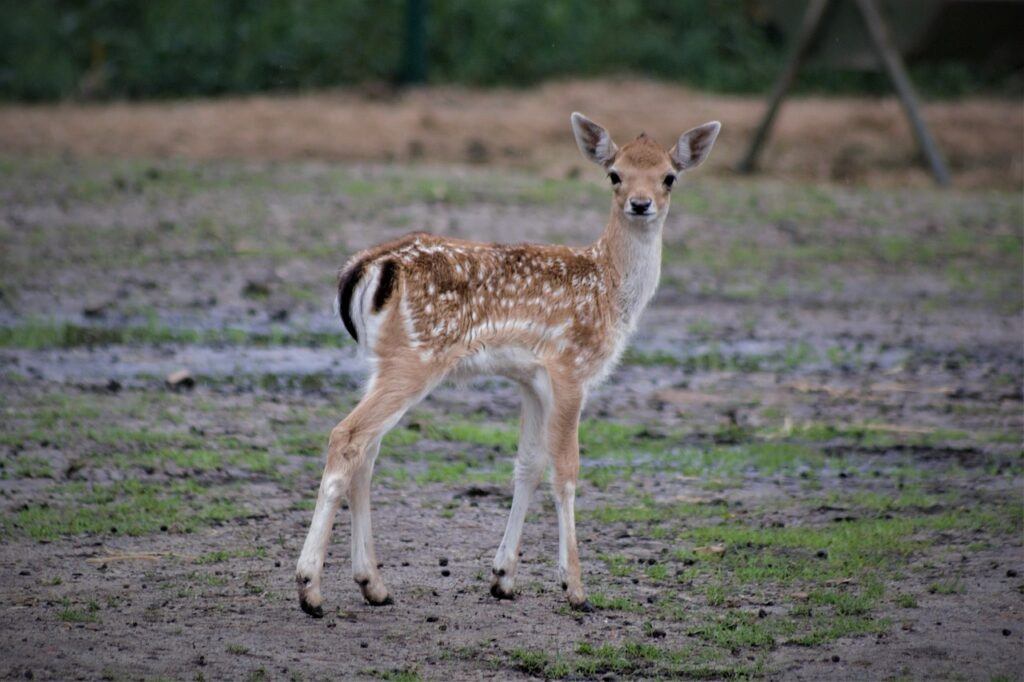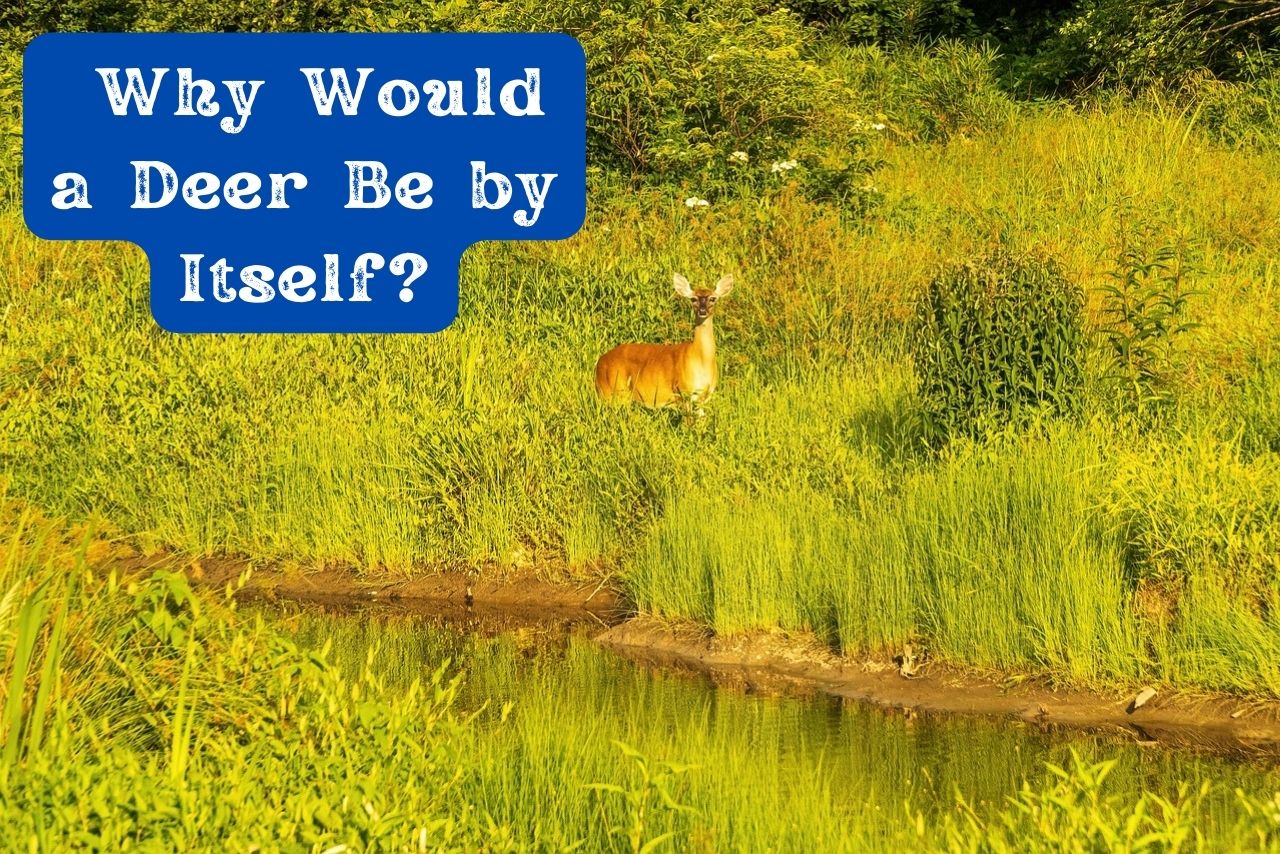Everything we know about deer tells us that they are social animals that prefer to live in herds.
We are used to viewing these animals in groups far more than seeing them alone.
But every now and again you may see a deer by itself and wonder, what exactly is going on here?
Why would a deer be by itself?
Deer may occasionally be seen alone because they are Pregnant Does, Wandering Fawns, or Rutting Bucks. Additionally, a deer may be by itself due to Illness or Injury or Human Interference. Other times a deer may appear to be alone but, It’s an Illusion!
Pregnant Does
Although pregnant does typically stick with their herds, they often isolate themselves when they’re close to giving birth.
They will seek a quiet, grassy place known as a “fawning area.”
The grass provides a soft bed for the mother to give birth on.
Does also prefer somewhere with tall grass so they are more concealed.
Conventional wisdom suggests they do this to remain hidden from any potential predators while they are in a vulnerable state.
However, it is unclear why they cannot rely on their herd to protect them during this time.
Perhaps it’s not a trust issue, but just because travelling becomes more difficult for them.
The herd may not be willing to slow down to accommodate the pregnant doe or it may just increase the vulnerability of the entire group.
Another interesting fact is that does typically return to the same fawning areas they’ve used in the past.
Wandering Fawns

After fawns are born, they are quick to get on their feet and be mischievous!
It is completely normal to see these little guys on their own from their very first days on earth.
What may seem like abandonment from their mothers is actually quite the opposite.
Does are very vulnerable from predators in the days and weeks following their pregnancy.
The deer are very tired and weak from the birthing process which is akin to ringing the dinner bell for a predator in the wild.
By separating from their babies, they are giving them a better chance for survival.
Remember the tall grass we just talked about, it’s perfect for concealing their young in these early days.
But don’t be fooled! While fawns may appear to be alone, you can bet your bottom dollar that the mother is nearby and watching EVERYTHING!
They will quickly intervene if anything looks threatening. Mothers will also assist in relocating their fawns if the area is no longer suitable.
Does obviously visit their babies periodically to feed them as well.
Did you know that if a doe gives birth to multiple fawns at the same time, she will separate the babies to increase their collective chance of survival?
Rutting Bucks
While does typically remain in herds (when not close to birth), mature bucks will go their own way in the fall.
Why the fall? Because this is when the rut takes place.
Bucks will break away from the bachelor groups they formed over the summer to pursue mating partners in the fall.
The rut will last for the entire season and even continue into early winter sometimes.
So why is it exactly that bucks decide to be by themselves during the rut? Because they are in constant competition with other bucks for mating partners.
Bucks’ testosterone will peak during this season and they have no issue with battling other bucks for does.
Doesn’t exactly seem like the right environment to bring back that bachelor group does it?
In any event, if you see a buck by itself during the fall, it’s because the buck is scouting does to be their breeding partners.
Illness or Injury
Deer who have certain illnesses or injuries may choose to isolate themselves.
This could be due to the fact that they can no longer keep up with the herd or maybe there is an instinctual element to prevent the transmission of disease.
One such disease is Chronic Wasting Disease, affectionally known as “Zombie Deer Disease.”
When a deer has this fatal disease they will often be seen by themselves and act as a drunk human would.
They stagger, sometimes foam at the mouth, and lose their sense of fear for humans and other animals.
That is why it is absolutely essential that you do not touch a deer if it looks like it’s approachable! There are several reasons why a deer may let you touch it, but it is NEVER a good idea to do so!
Deer will also be seen by themselves sometimes if they are injured.
There is no way a deer with a broken leg would be able to travel with the herd. It will eventually become isolated until it can recover or unfortunately succumb to its injury.
Want to see the craziest example of a deer by itself due to injury? Check out this whitetail buck that is missing an enormous piece of flesh (not for the faint of heart):
Human Interference
Another reason why you may spot a deer by itself is because of some form of human interference.
Some examples of this could be:
- Construction projects
- Habitat destruction
- Hunting
- Car collisions
- Accidentally scaring deer
These are just a few ways that humans can drive individual deer away from their herds.
Deer are very skittish animals that can take off in random directions if they feel scared or threatened.
This causes them to become disoriented and easily separated from their groups.
When this happens, deer will be on their own and forced to search for their herd, find a new herd, or potentially fall prey to predators during this vulnerable time.
If you happen to see one by itself please keep your distance. It will let you know that it’s displeased with your presence by snorting or blowing out its nose!
It’s an Illusion
Last but not least, what may appear to be a deer by itself may in fact just be a few feet away from its herd.
It’s not uncommon for a herd member to venture off a little bit without being a large distance from the main group.
Have you ever seen a deer run across the street?
How many times did you think it was just a single solitary deer when moments later you see its friends doing the exact same thing?
That is why it’s paramount that you drive with extreme caution when you see a deer in the street.
Chances are the rest of the herd isn’t far behind it and will do the exact same thing!
Deer are very social animals and don’t normally go on their own so when you see one alone, there is a very high probability that you simply can’t see the rest of the herd.
Final Thoughts
Now you know the 6 most common reasons for why you may see a deer by itself.
While there are some very good reasons why this may be the case, remember that the odds are you just can’t see the rest of the herd.
Regardless of the reason why you may spot a lonesome deer, always remember to keep your distance from these animals.
It’s important to respect their space to prevent injury to both you and them.
These animals act very erratically when spooked so it’s in everyone’s best interest to just leave them be.
Lastly, if you happen to be a hunter and spot a big buck by itself during hunting season, disregard everything that was just said!
We really hope you enjoyed our article and welcome you to share some of your experiences with seeing a deer by itself.

